Evaluation of Radar-Rainfall Products over Coastal Louisiana
Abstract
1. Introduction
2. Study Area and Datasets
2.1. Radar-Rainfall Products
2.2. Rain Gage Network
3. Methods
3.1. Spatial Radar-Rainfall Accumulation
3.2. Unconditional and Conditional Statistical Analysis
4. Results
4.1. Spatial Accumulation Maps
4.2. Assessment of Unconditional Error Statistics
4.3. Probability of Exceedance Analysis
4.4. Bias Decomposition
4.5. Conditional Analysis
5. Discussion
6. Summary and Conclusions
- Overall, based on visual inspection of the annual accumulation maps, both products show similar spatial accumulations at the annual scale, with MRMS showing more high-intensity clusters, attributable to its higher spatial resolution. Improvements in spatial mosaicking in Stage IV rainfall product were apparent starting in 2015, mainly due to the incorporation of base reflectivity fields from the MRMS system. Nevertheless, other spatial artifacts such as beam blockage and halo-shaped rainfall overestimation around some radar locations are still present in both products.
- Direct comparisons against the reference rainfall showed considerable differences as large as 15–30 mm/h at the hourly scale, 30−45 mm/day at the daily scale and 50−70 mm/month at the monthly scale. Despite the significant scatter at the hourly scale, both radar products showed better agreement with the surface rainfall as the time scale increases beyond hourly. The most improvement is achieved by going from the hourly to 6-hour scale.
- The distributions of radar-rainfall intensities slightly overestimated the occurrence of small rainfall intensities compared to the reference rainfall, but deviate significantly at the extreme tail (large intensities) where the radar products underestimate the probability of occurrences compared to the rain gages. Closer agreement is evident between the tails of the radar-gage distributions at daily scale indicating an improved performance as time scale increases.
- Both products have an overall total positive bias, with false-rain and missed-rainfall bias components being the largest contributors.
- Stage IV and MRMS consistently underestimated rainfall when conditioned on specific reference rainfall rates. The conditional bias deteriorates almost linearly with increasing rainfall rates, with biases reaching −10 to −15 mm/h at the 50 mm/h rate of surface rainfall. Similarly, both products show dependence of the random error on the magnitude of surface rainfall. The standard deviation of the random increases proportionally to rainfall intensities, reaching as high as 15 mm/h at the 50 mm/h rate of surface rainfall.
Author Contributions
Funding
Acknowledgments
Conflicts of Interest
References
- Habib, E.; Haile, A.T.; Tian, Y.; Joyce, R.J. Evaluation of the high-resolution CMORPH satellite rainfall product using dense rain gage observations and radar-based estimates. J. Hydrometeorol. 2012, 13, 1784–1798. [Google Scholar] [CrossRef]
- Lee, T.; Sacks, L.; Swancar, A. Exploring the long-term balance between net precipitation and net groundwater exchange in Florida seepage lakes. J. Hydrol. 2014, 519, 3054–3068. [Google Scholar] [CrossRef]
- Habib, E.; Qin, L. Application of a radar-rainfall uncertainty model to the NWS multi-sensor precipitation estimator products. Meteorol. App. 2011, 20, 276–286. [Google Scholar] [CrossRef]
- Kitzmiller, D.; Miller, D.; Fulton, R.; Ding, F. Radar and multisensor precipitation estimation techniques in National Weather Service hydrological operations. J. Hydrol. Eng. 2013, 18, 133–142. [Google Scholar] [CrossRef]
- Eldardiry, H.; Habib, E.; Zhang, Y.; Graschel, J. Artifacts in Stage IV NWS real-time multisensor precipitation estimates and impacts on identification of maximum series. J. Hydrol. Eng. 2015, 22, E4015003. [Google Scholar] [CrossRef]
- Gourley, J.J.; Calvert, C.M. Automated detection of the bright band using WSR-88D data. Weather. Forecast. 2003, 18, 585–599. [Google Scholar] [CrossRef]
- Krajewski, W.F.; Villarini, G.; Smith, J.A. RADAR-rainfall uncertainties. Q. J. R. Meteorol. Soc. 2009, 91, 87–94. [Google Scholar] [CrossRef]
- Lin, Y.; Mitchell, K.E. The NCEP Stage II/IV hourly precipitation analyses: Development and applications. In Proceedings of the 19th Conference on Hydrology, American Meteorological Society, San Diego, CA, USA, 9–13 January 2005. [Google Scholar]
- Zhang, J.; Howard, K.; Langston, C.; Kaney, B.; Qi, Y.; Tang, L.; Grams, H.; Wang, Y.; Cocks, S.; Martinaitis, S.; et al. Multi-Radar Multi-Sensor (MRMS) quantitative precipitation estimation: Initial operating capabilities. Bull. Am. Meteorol. Soc. 2016, 97, 621–638. [Google Scholar] [CrossRef]
- Nelson, B.R.; Prat, O.P.; Seo, D.; Habib, E. Assessment and implications of NCEP Stage IV quantitative precipitation estimates for product intercomparisons. Weather. Forecast. 2016, 31, 371–394. [Google Scholar] [CrossRef]
- Seo, B.C.; Cunha, L.K.; Krajewski, W.F. Uncertainty in radar-rainfall composite and its impact on hydrological prediction for the eastern Iowa flood of 2008. Water Resour. Res. 2013, 49, 2747–2764. [Google Scholar] [CrossRef]
- Kim, D.; Nelson, B.; Seo, D.J. Characteristics of reprocessed Hydrometeorological Automated Data System (HADS) hourly precipitation data. Weather. Forecast. 2009, 24, 1287–1296. [Google Scholar] [CrossRef]
- Habib, E.; Qin, L.; Seo, D.; Ciach, G.J.; Nelson, B.R. Independent assessment of incremental complexity in NWS multisensor precipitation estimator algorithms. J. Hydrol. Eng. 2013, 18, 143–155. [Google Scholar] [CrossRef]
- Prat, O.P.; Nelson, B.R. Evaluation of precipitation estimates over CONUS derived from satellite, radar, and rain gage data sets at daily to annual scales (2002–2012). Hydrol. Earth Syst. Sci. 2015, 19, 2037–2056. [Google Scholar] [CrossRef]
- Adams, T.E., III; Dymond, R.L. Possible hydrological forecasting improvements resulting from advancements in precipitation estimation and forecasting for a real-time flood forecast system in the Ohio River Valley USA. J. Hydrol. 2019, 579, 124138. [Google Scholar] [CrossRef]
- Habib, E.; Larson, B.F.; Graschel, J. Validation of NEXRAD multisensor precipitation estimates using an experimental dense rain gage network in south Louisiana. J. Hydrol. 2009, 373, 463–478. [Google Scholar] [CrossRef]
- Wu, W.; Kitzmiller, D.; Wu, S. Evaluation of radar precipitation estimates from the national mosaic and multisensor quantitative precipitation estimation system and the WSR-88D precipitation processing system over the conterminous United States. J. Hydrometeorol. 2011, 13, 1080–1093. [Google Scholar] [CrossRef]
- Chen, S.; Gourley, J.J.; Hong, Y.; Kirstetter, P.E.; Zhang, J.; Howard, K.; Flamig, Z.L.; Hu, J.; Qi, Y. Evaluation and uncertainty estimation of NOAA/NSSL next-generation National Mosaic Quantitative Precipitation Estimation product (Q2) over the continental United States. J. Hydrometeorol. 2013, 14, 1308–1322. [Google Scholar] [CrossRef]
- Seo, B.C.; Krajewski, W.F.; Quintero, F.; ElSaadani, M.; Goska, R.; Cunha, L.K.; Dolan, B.; Wolff, D.B.; Smith, J.A.; Rutledge, S.A.; et al. Comprehensive evaluation of the IFloodS radar rainfall products for hydrological applications. J. Hydrometeorol. 2018, 19, 1793–1813. [Google Scholar] [CrossRef]
- Habib, E.; Larson, B.F.; Nuttle, W.K.; Rivera-Monroy, V.H.; Nelson, B.R.; Meselhe, E.A.; Twilley, R.R. Effect of rainfall spatial variability and sampling on salinity prediction in an estuarine system. J. Hydrol. 2008, 350, 56–67. [Google Scholar] [CrossRef]
- Gourley, J.J.; Hong, Y.; Flamig, Z.L.; Wang, J.H.; Vergara, H.; Anagnostou, E.N. Hydrological evaluation of rainfall estimates from radar, satellite, gage, and combinations on Ft. Cobb basin, Oklahoma. J. Hydrometeorol. 2011, 12, 973–988. [Google Scholar] [CrossRef]
- Cunha, L.K.; Mandapaka, P.V.; Krajewski, W.F.; Mantilla, R.; Bradley, A.A. Impact of radar-rainfall error structure on estimated flood magnitude across scales: An investigation based on a parsimonious distributed hydrological model. Water Resour. Res. 2012, 48, W10515. [Google Scholar] [CrossRef]
- Quintero, F.; Krajewski, W.F.; Mantilla, R.; Small, S.; Seo, B. A spatial–dynamical framework for evaluation of satellite rainfall products for flood prediction. J. Hydrometeorol. 2016, 17, 2137–2154. [Google Scholar] [CrossRef]
- ElSaadani, M. A Spatio-temporal Dynamical Evaluation of Satellite Rainfall Products in Hydrological Applications. Ph.D. Thesis, University of Iowa, Iowa City, IA, USA, August 2017. [Google Scholar]
- ElSaadani, M.; Krajewski, W.F.; Zimmerman, D.L. River network based characterization of errors in remotely sensed rainfall products in hydrological applications. Rem. Sens. Let. 2018, 9, 743–752. [Google Scholar] [CrossRef]
- Xie, T.; Cui, B.; Li, S.; Wang, Q.; Shi, W. Rainfall variation shifts habitat suitability for seedling establishment associated with tidal inundation in salt marshes. Ecol. Indic. 2018, 98, 694–703. [Google Scholar] [CrossRef]
- Summer, D.M.; Belaineh, G. Evaporation, Precipitation, and Associated Salinity Changes at a Humid, Subtropical Estuary. Estuaries 2005, 28, 844–855. [Google Scholar] [CrossRef]
- Louisiana Coastal Protection and Restoration Authority. Louisiana’s Comprehensive Master Plan for a Sustainable Coast. Louisiana Coastal Protection and Restoration Authority, Baton Rouge. 2012. Available online: https://coastal.la.gov/2012-coastal-master-plan/ (accessed on 4 May 2020).
- Louisiana Coastal Protection and Restoration Authority. Louisiana’s Comprehensive Master Plan for a Sustainable Coast. Louisiana Coastal Protection and Restoration Authority, Baton Rouge. 2017. Available online: http://coastal.la.gov/our-plan/2017-coastal-master-plan/ (accessed on 4 May 2020).
- Young, C.B.; Morrissey, M.L.; Krajewski, W.F.; Bradley, A.A.; Kruger, A. Evaluating NEXRAD Multisensor Precipitation Estimates for operational hydrological forecasting. J. Hydrometeorol. 2000, 1, 241–254. [Google Scholar] [CrossRef]
- Zhang, Y.; Reed, S.; Kitzmiller, D. Effects of retrospective gage-based readjustment of multisensor precipitation estimates on hydrological simulations. J. Hydrometeorol. 2010, 12, 429–443. [Google Scholar] [CrossRef]
- Lopez, P. Direct 4D-Var assimilation of NCEP Stage IV radar and gage precipitation data at ECMWF. Month. Weath. Rev. 2011, 139, 2098–2116. [Google Scholar] [CrossRef]
- Smalley, M.; L’Ecuyer, T.; Lebsock, M.; Haynes, J. A comparison of precipitation occurrence from the NCEP Stage IV QPE product and the CloudSat cloud profiling radar. J. Hydrometeorol. 2013, 15, 444–458. [Google Scholar] [CrossRef]
- Reed, S.M.; Maidment, D.R. Coordinate Transformations for Using NEXRAD Data in GIS-based Hydrological Modeling. J. Hydrol. Eng. 1999, 4, 174–182. [Google Scholar] [CrossRef]
- Fulton, R.A.; Miller, D.A.; Seo, D.-J.; Breidenbach, J.P.; O’Bannon, T. The WSR-88D rainfall algorithm. Weather. Forecast. 1998, 13, 377–395. [Google Scholar] [CrossRef]
- Qi, Y.; Martinaitis, S.; Zhang, J.; Cocks, S. A real-time automated quality control of hourly rain gage data based on multiple sensors in MRMS system. J. Hydrometeorol. 2016, 17, 1675–1691. [Google Scholar] [CrossRef]
- Lewis, E.; Quinn, N.; Blenkinsop, S.; Fowler, H.J.; Freer, J.; Tanguy, M.; Hitt, O.; Coxon, G.; Bates, P.; Woods, R. A rule based quality control method for hourly rainfall data and a 1 km resolution gridded hourly rainfall dataset for Great Britain: CEH-GEAR1hr. J. Hydrol. 2018, 564, 930–943. [Google Scholar] [CrossRef]
- Hamada, A.; Arakawa, O.; Yatagai, A. An automated quality control method for daily rain-gage data. Glob. Environ. Res. 2011, 15, 183–192. [Google Scholar]
- Blenkinsop, S.; Lewis, E.; Chan, S.C.; Fowler, H.J. Quality-control of an hourly rainfall dataset and climatology of extremes for the UK. Int. J. Climatol. 2016, 37, 722–740. [Google Scholar] [CrossRef]
- Villarini, G.; Mandapaka, P.V.; Krajewski, W.F.; Moore, R.J. Rainfall and sampling uncertainties: A rain gage perspective. J. Geophys. Res. Atmos. 2008, 113, 1–12. [Google Scholar] [CrossRef]
- Habib, E.; Krajewski, W.F. Uncertainty analysis of the TRMM ground-validation radar-rainfall products: Application to the TEFLUN-B field campaign. J. App. Meteorol. 2002, 41, 558–572. [Google Scholar] [CrossRef]
- Ciach, G.J.; Krajewski, W.F.; Villarini, G. Product-error-driven uncertainty model for probabilistic quantitative precipitation estimation with NEXRAD data. J. Hydrometeorol. 2007, 8, 1325–1347. [Google Scholar] [CrossRef]
- Jayakrishnan, R.; Srinivasan, R.; Arnold, J.G. Comparison of raingage and WSR-88D Stage III precipitation data over the Texas-Gulf basin. J. Hydrol. 2004, 292, 135–152. [Google Scholar] [CrossRef]
- Yilmaz, K.K.; Hogue, T.S.; Hsu, K.; Sorooshian, S.; Gupta, H.V.; Wagner, T. Intercomparison of rain gauge, radar, and satellite-based precipitation estimates with emphasis on hydrological forecasting. J. Hydrometeor. 2005, 6, 497–517. [Google Scholar] [CrossRef]
- Over, T.M.; Murphy, E.A.; Ortel, T.W.; Ishii, A.L. Comparisons between NEXRAD radar and tipping-bucket gage rainfall data: A case study for DuPage county, Illinois. In Proceedings of the World Environmental and Water Resources Congress, Tampa, FL, USA, 15–19 May 2007. [Google Scholar]
- Young, C.B.; Brunsell, N.A. Evaluating NEXRAD estimates for the Missouri River basin: Analysis using daily raingauge data. J. Hydrol. Eng. 2008, 13, 549–553. [Google Scholar] [CrossRef][Green Version]
- Wang, X.; Xie, H.; Sharif, H.; Zeitler, J. Validating NEXRAD MPE and Stage III precipitation products for uniform rainfall on the Upper Guadalupe River Basin of the Texas Hill Country. J. Hydrol. 2008, 348, 73–86. [Google Scholar] [CrossRef]
- Nelson, B.R.; Seo, D.-J.; Kim, D. Multisensor Precipitation Reanalysis. J. Hydrometeor. 2010, 11, 666–682. [Google Scholar] [CrossRef]
- Kursinski, A.L.; Mullen, S.L. Spatiotemporal variability of hourly precipitation over the eastern contiguous United States from Stage IV multisensor analyses. J. Hydrometeorol. 2008, 9, 3–21. [Google Scholar] [CrossRef]
- Boyles, R.; Raman, S.; Sims, A.; Schwab, S.; Horgan, K.; Brooks, M.; Frazier, A. January Evaluation and applications of NCEP stage II and stage IV gage-corrected radar precipitation estimates over the Carolinas. In Proceedings of the 20th Conference on Hydrology, Atlanta, GA, USA, 30 January 2006. [Google Scholar]
- Westcott, N.E.; Knapp, H.V.; Hilberg, S.D. Comparison of gage and multi-sensor precipitation estimates over a range of spatial and temporal scales in the Midwestern United States. J. Hydrol. 2008, 351, 1–12. [Google Scholar] [CrossRef]
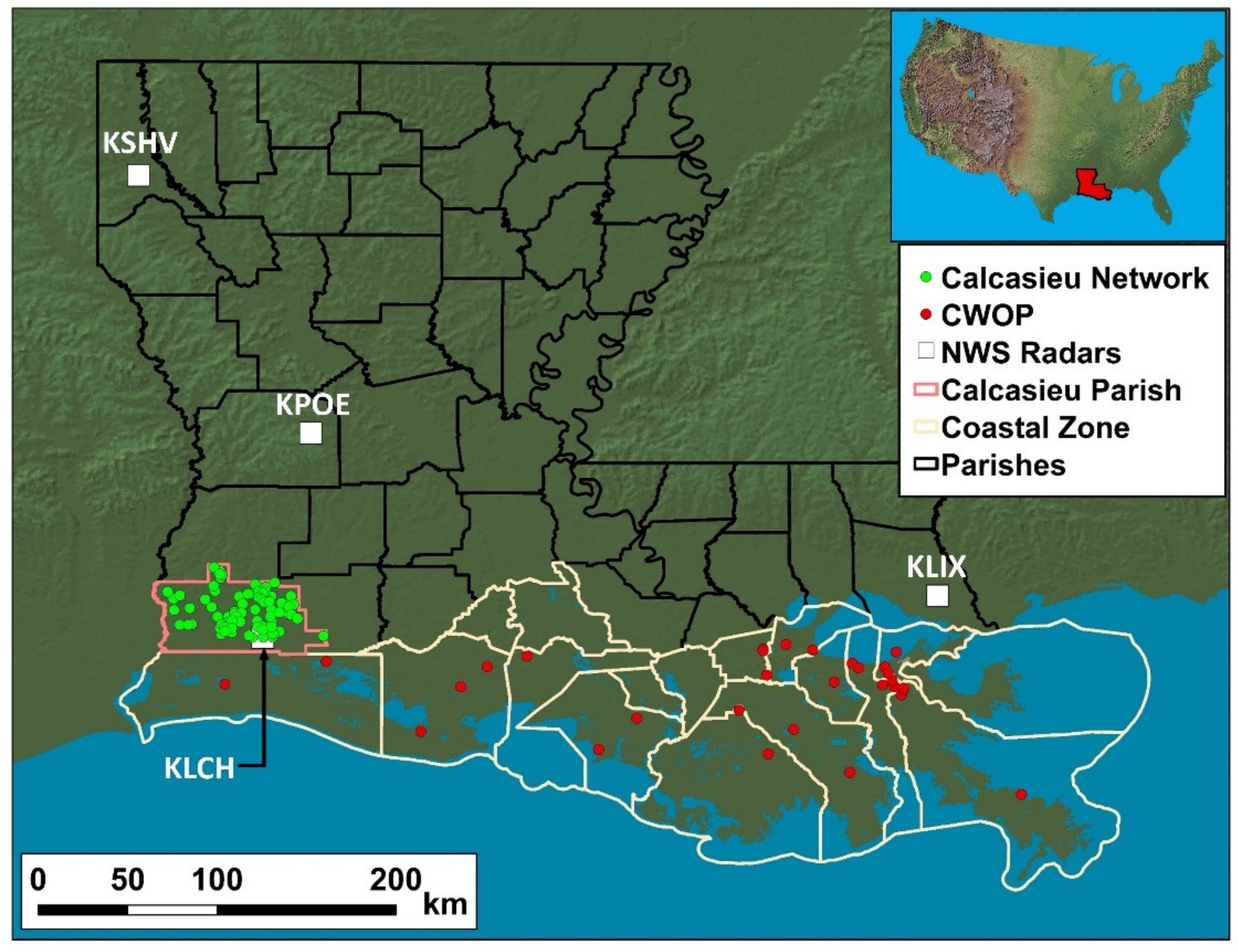
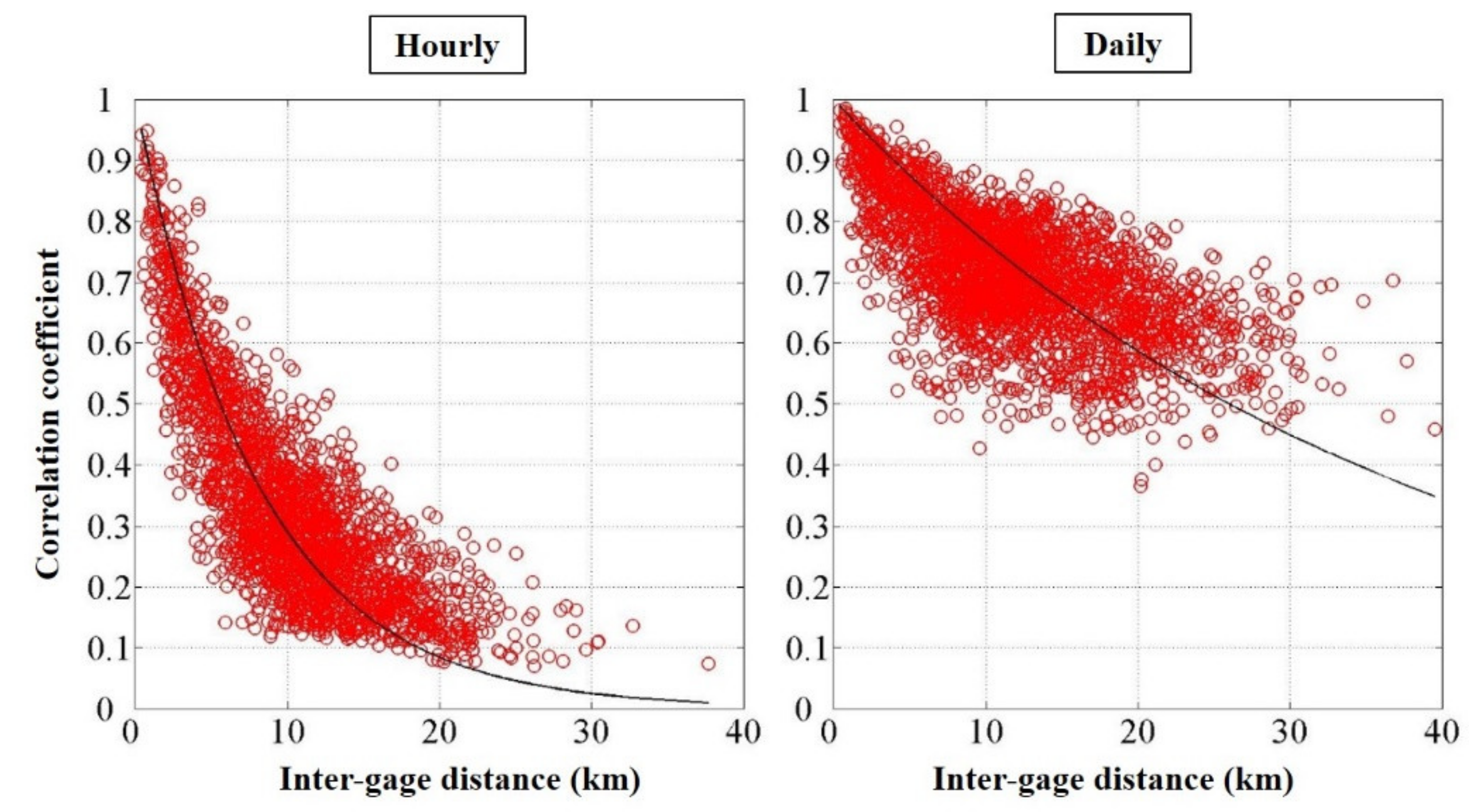
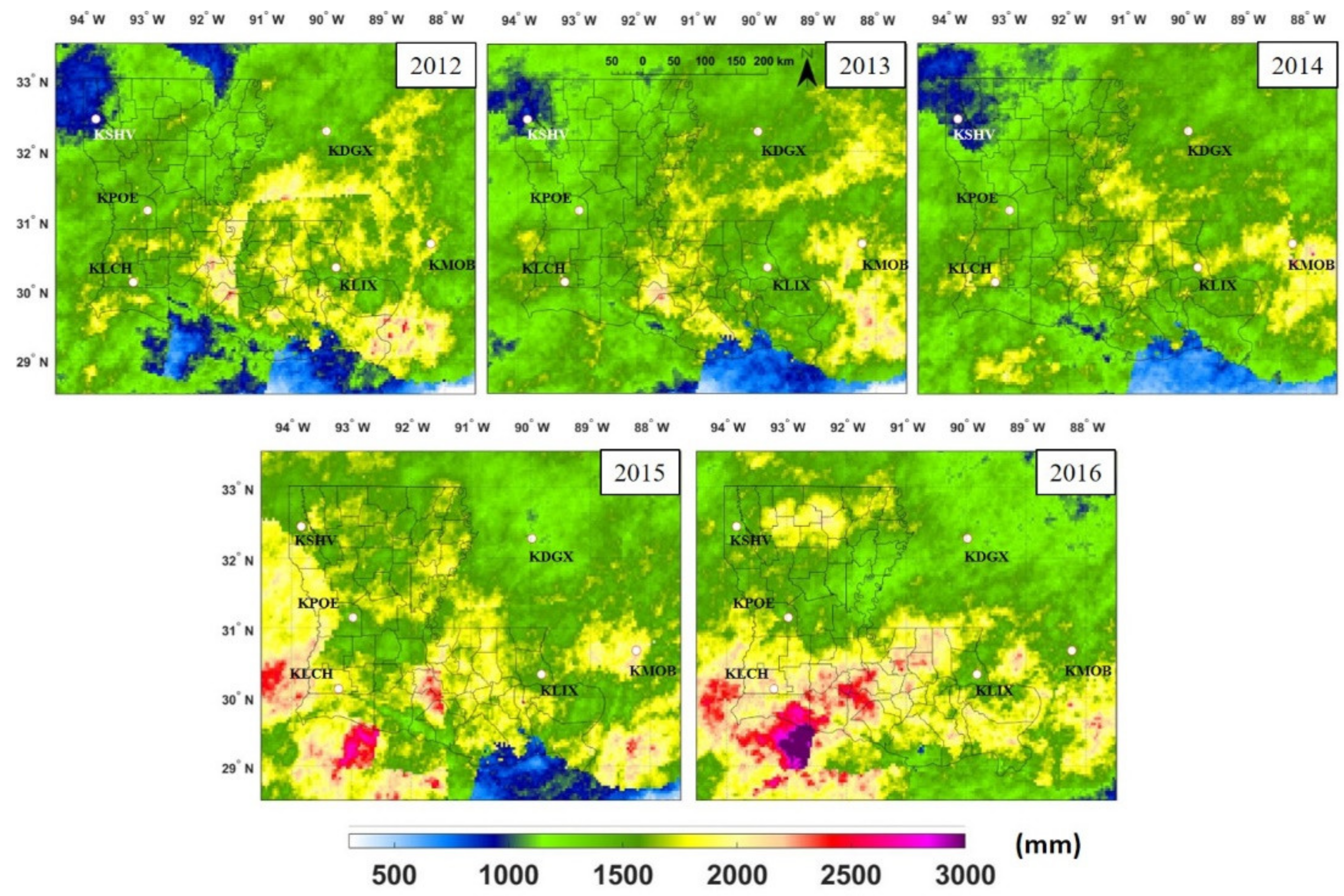
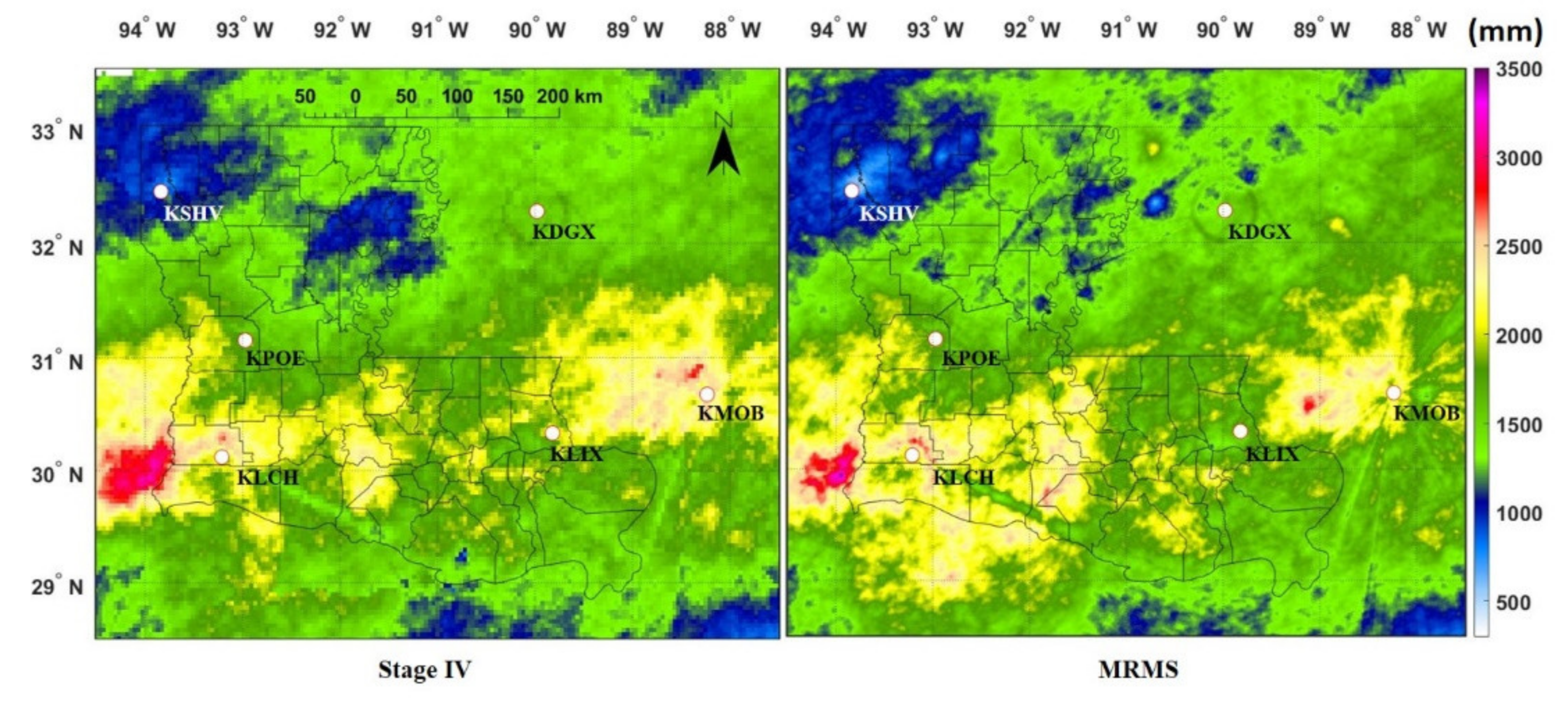
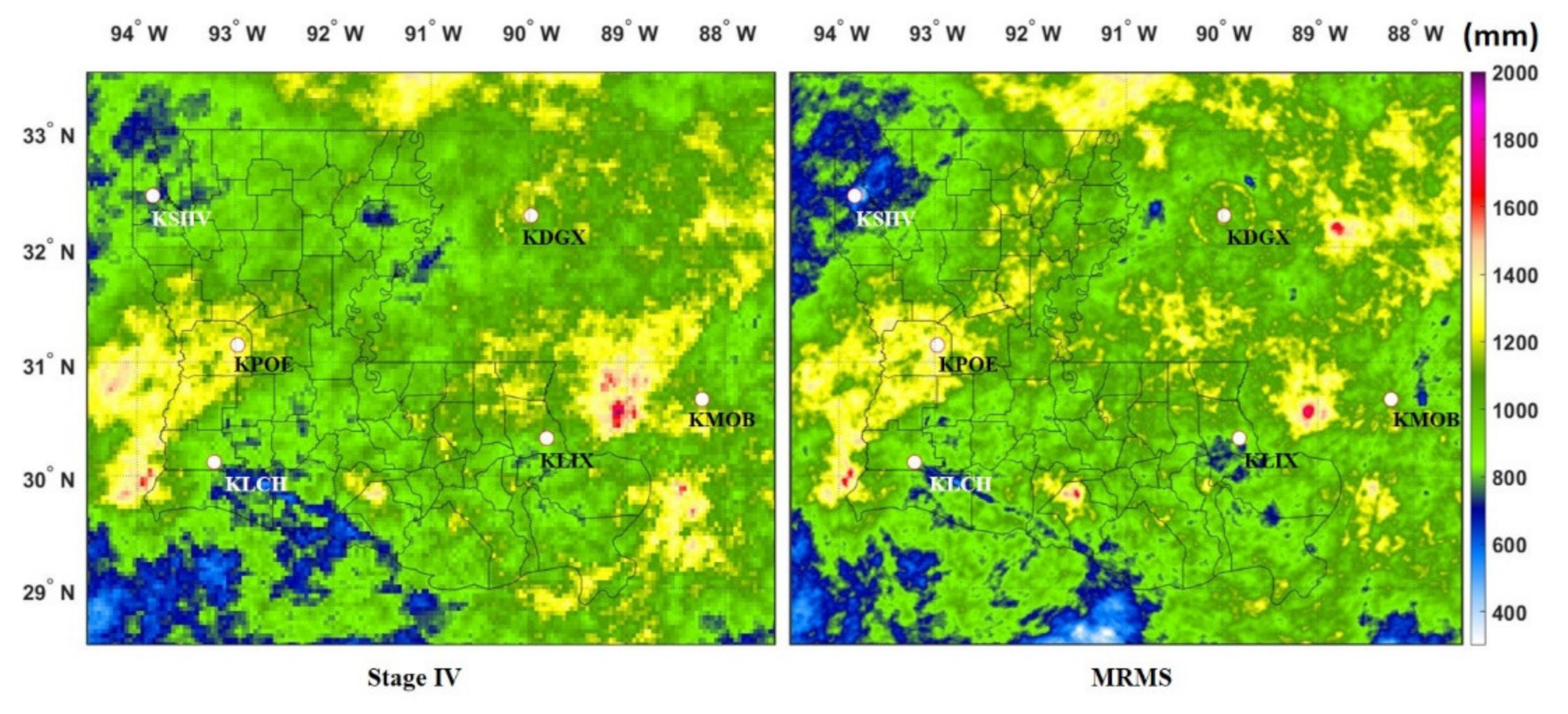
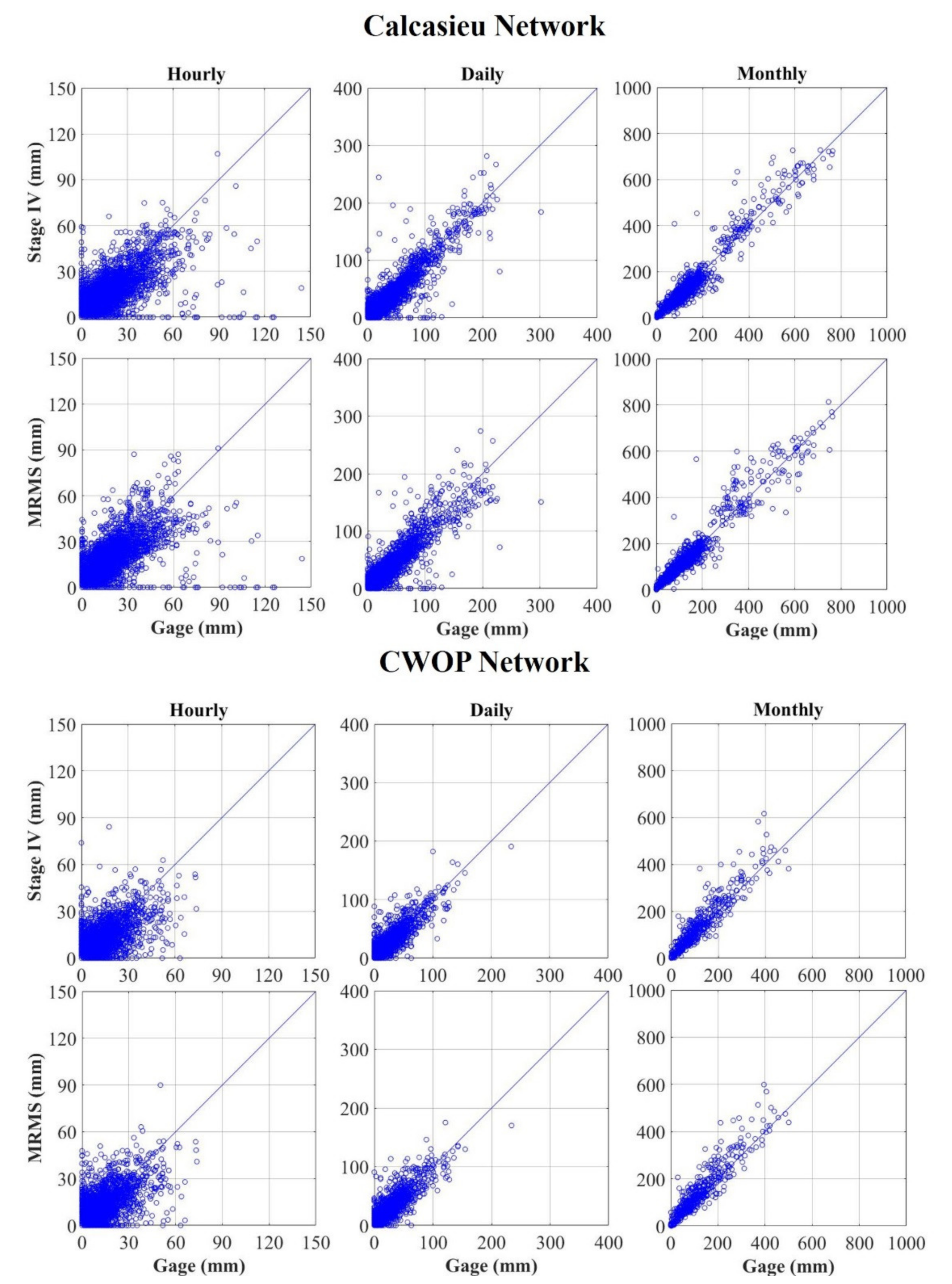
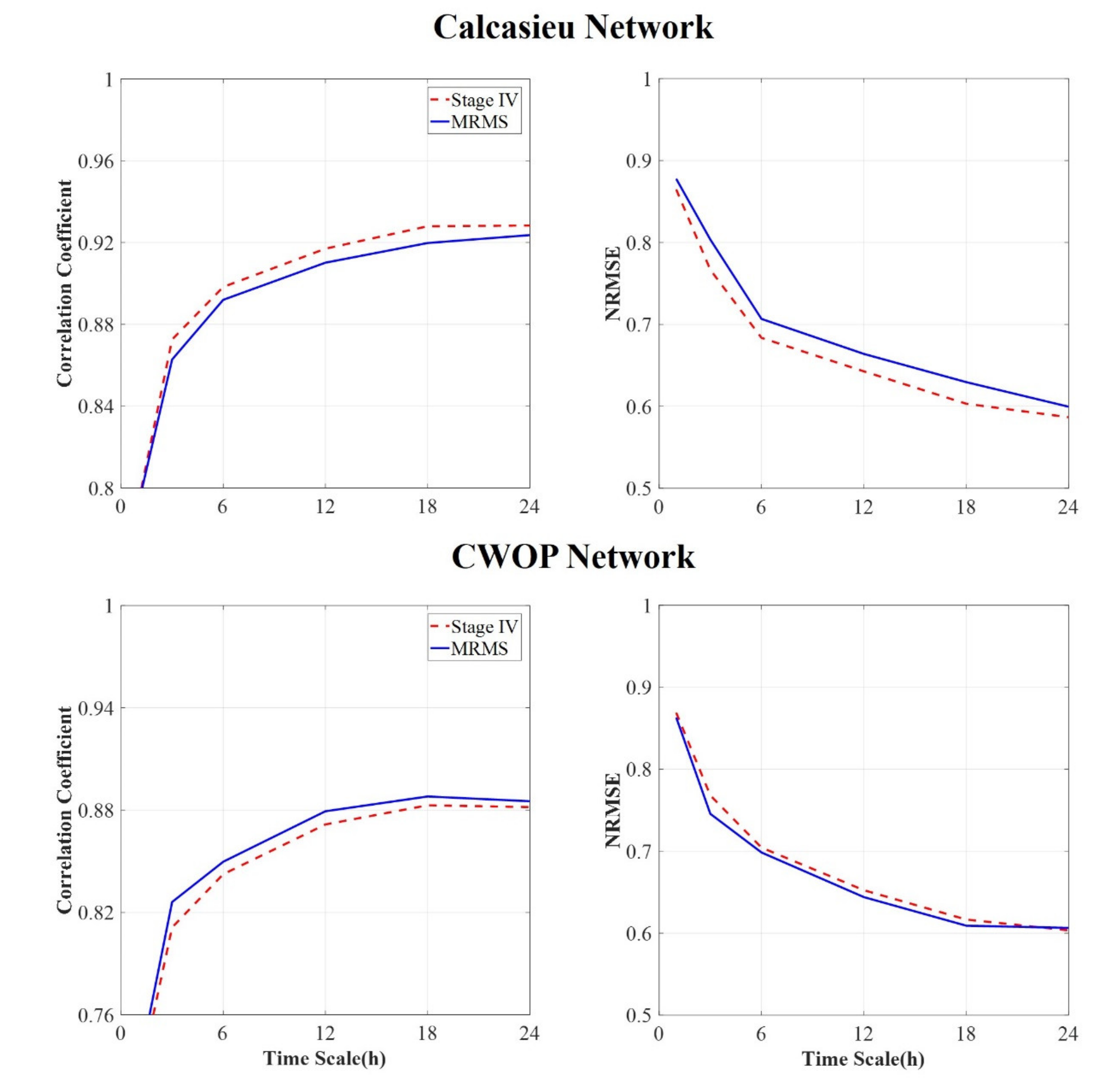
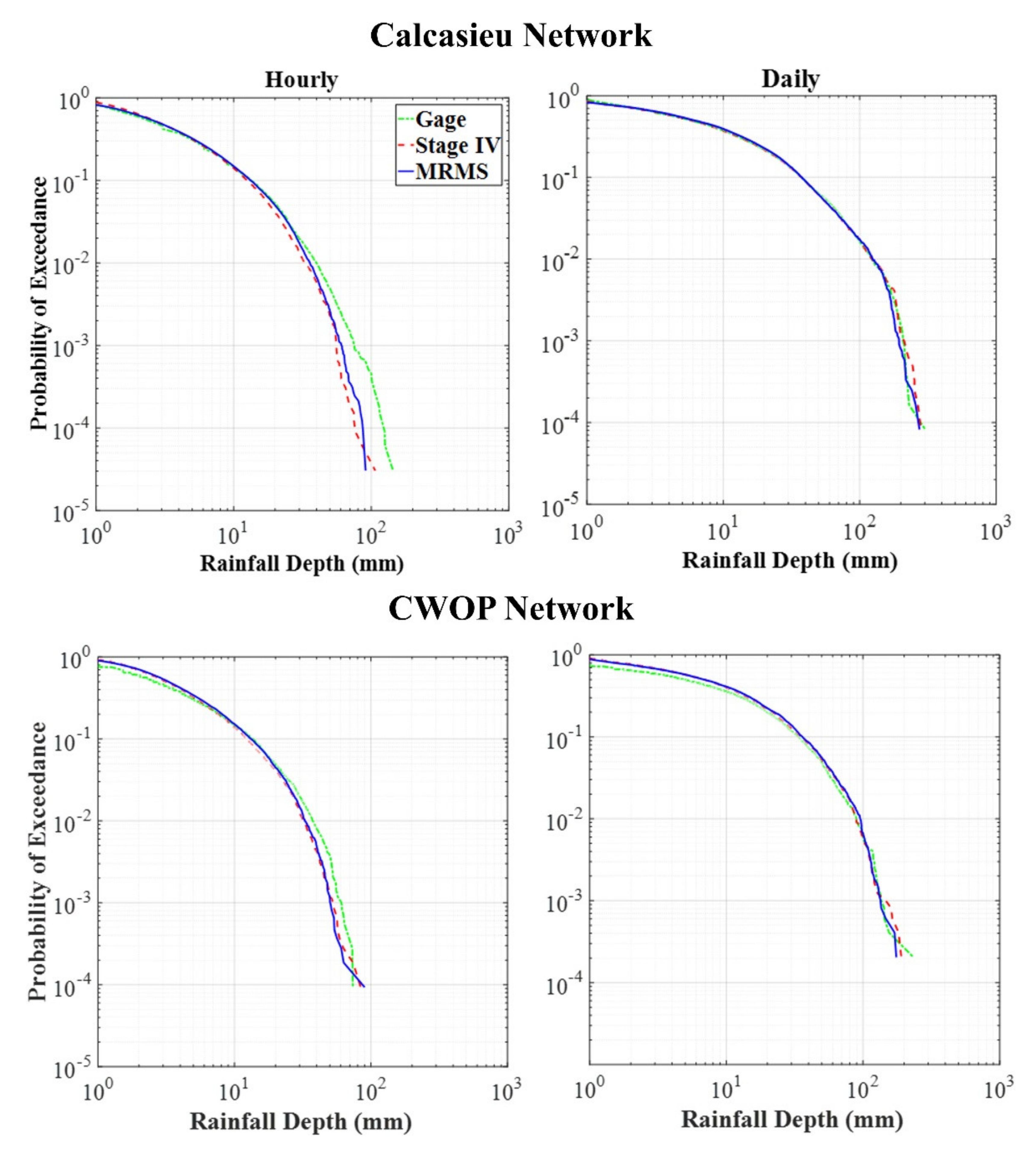
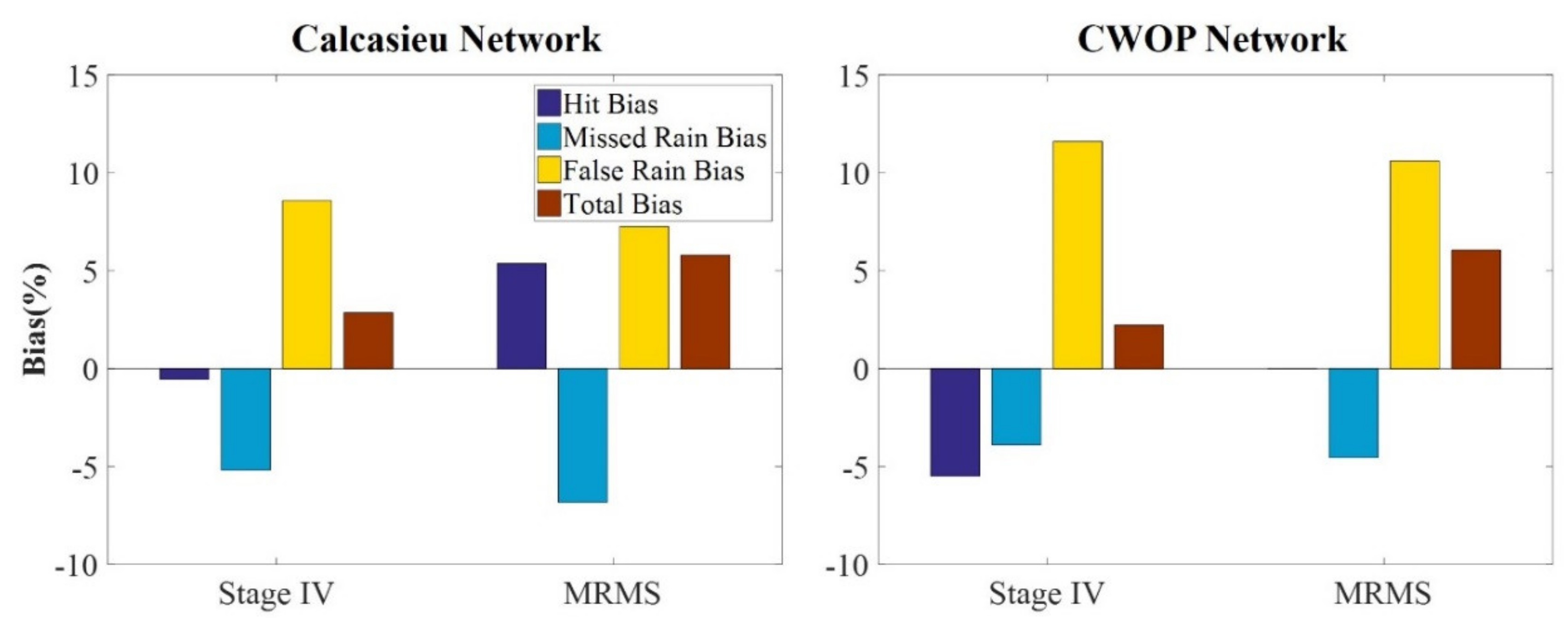
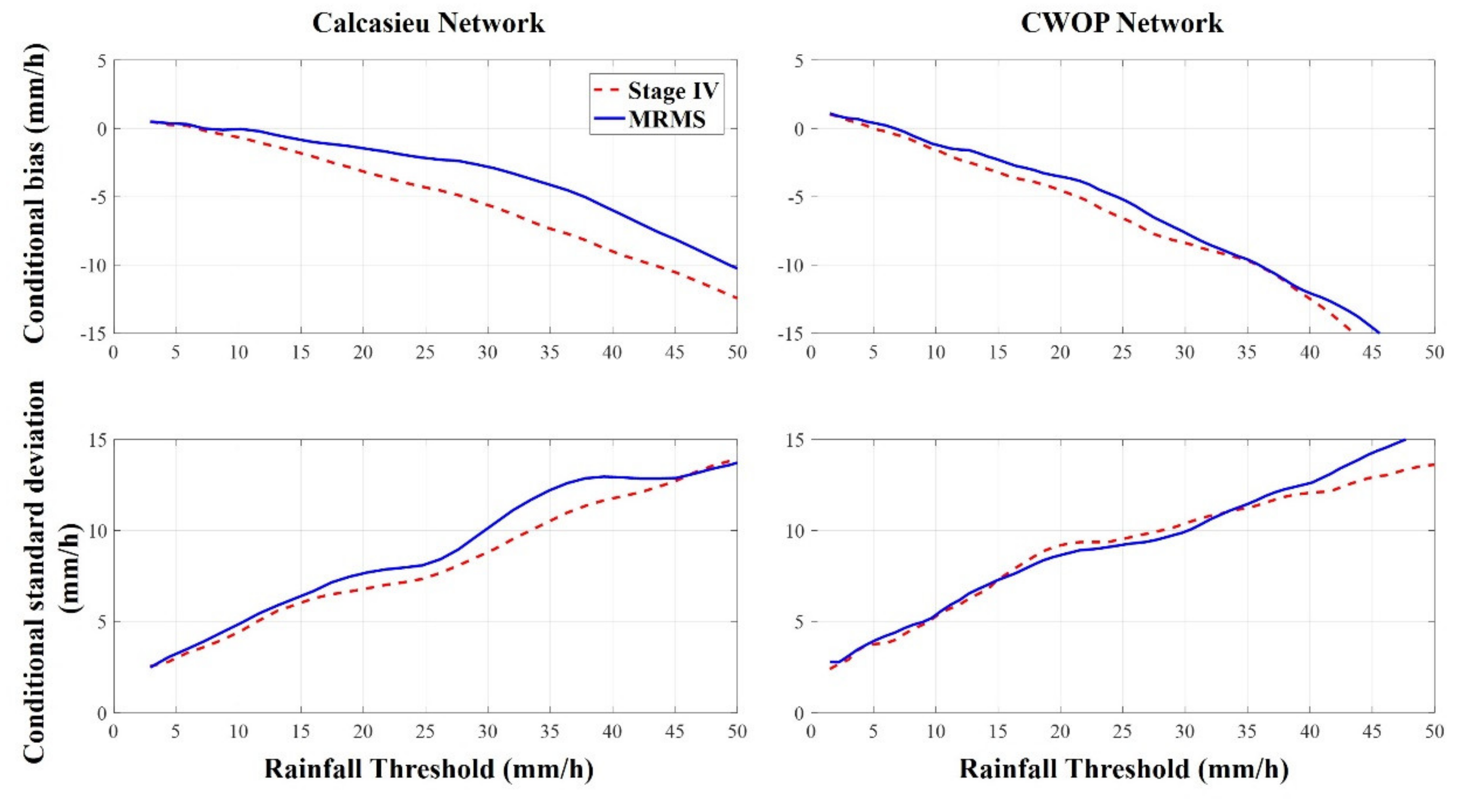
| Average Rainfall Depth (mm) | Bias (mm/Unit Time) | Standard Deviation of Error (mm/Unit Time) | Correlation Coefficient | NRMSE | |||
|---|---|---|---|---|---|---|---|
| Calcasieu Network | Stage IV | Hourly | 4.76 | 0.03 | 4.78 | 0.79 | 0.86 |
| Daily | 14.70 | 0.17 | 9.22 | 0.93 | 0.58 | ||
| Monthly | 146.85 | 0.55 | 35.63 | 0.96 | 0.24 | ||
| MRMS | Hourly | 5.03 | 0.33 | 4.88 | 0.79 | 0.88 | |
| Daily | 15.37 | 0.39 | 9.46 | 0.92 | 0.60 | ||
| Monthly | 150.57 | 3.82 | 37.41 | 0.96 | 0.26 | ||
| CWOP Network | Stage IV | Hourly | 5.09 | 0.14 | 5.39 | 0.70 | 0.87 |
| Daily | 14.15 | 1.53 | 9.15 | 0.88 | 0.60 | ||
| Monthly | 135.70 | 15.54 | 39.47 | 0.93 | 0.34 | ||
| MRMS | Hourly | 5.43 | 0.32 | 5.40 | 0.71 | 0.86 | |
| Daily | 15.02 | 1.95 | 9.09 | 0.89 | 0.61 | ||
| Monthly | 138.79 | 18.87 | 39.59 | 0.93 | 0.36 |
© 2020 by the authors. Licensee MDPI, Basel, Switzerland. This article is an open access article distributed under the terms and conditions of the Creative Commons Attribution (CC BY) license (http://creativecommons.org/licenses/by/4.0/).
Share and Cite
Sharif, R.B.; Habib, E.H.; ElSaadani, M. Evaluation of Radar-Rainfall Products over Coastal Louisiana. Remote Sens. 2020, 12, 1477. https://doi.org/10.3390/rs12091477
Sharif RB, Habib EH, ElSaadani M. Evaluation of Radar-Rainfall Products over Coastal Louisiana. Remote Sensing. 2020; 12(9):1477. https://doi.org/10.3390/rs12091477
Chicago/Turabian StyleSharif, Ridwana Binte, Emad H. Habib, and Mohamed ElSaadani. 2020. "Evaluation of Radar-Rainfall Products over Coastal Louisiana" Remote Sensing 12, no. 9: 1477. https://doi.org/10.3390/rs12091477
APA StyleSharif, R. B., Habib, E. H., & ElSaadani, M. (2020). Evaluation of Radar-Rainfall Products over Coastal Louisiana. Remote Sensing, 12(9), 1477. https://doi.org/10.3390/rs12091477





